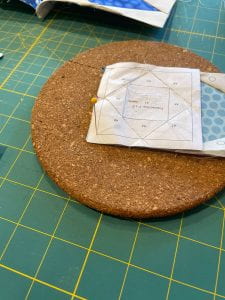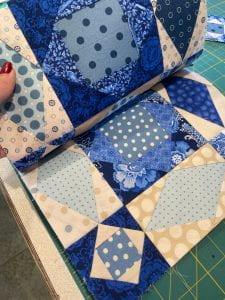Welcome to my final in-depth post! I have made great progress since the last update. Since I had completed all the individual pieces needed for this quilt in the last post, these past two weeks were spent sewing the top layer of the quilt together.
I experimented with two different techniques for sewing these pieces together. The first technique I tried was sewing two pieces together horizontally. Each vertical column has 9 pieces in it. I would take the first piece in two columns beside each other and sew these first pieces together. I repeated this process and sewed all 18 pieces in these two neighbouring columns into 9 pieces. After I had the 9 pieces I would sew these pieces together vertically creating one long strip of quilt.
The second technique I tried was sewing vertically first. I would take and individual column and sew each piece in that column together. Once I had sewn every piece in the individual column together I would sew it with a neighbouring individual row.
Both methods created the same effect but once I had tried both out I realized I liked the first method better because I have to sew half the long lines as method two.
The sewing process for this was quite repetitive but I did learn a few new tips. The most important part of sewing this piece is that every diamond point and seam lines up. The entire pattern is based on matching these two points so pinning was a big part of this process. My mentor recommended using more pins because “[she] would rather pull out pins then unpick” which I fully agree with. Taking out pins during sewing takes two seconds maybe but when I have to use the seam ripper and take out thread it will set me back ten minutes which can really set me back in a time crunch. The way she demonstrated pinning used a corkboard. I would take a pin and put it through both layers of pieces and the corkboard. My pinning into the cork I can easily lift the two pieces and see if the pin was on the diamond point on the paper piecing. If both points lined up, I could pin both pieces ensuring the pieces wouldn’t slip and if they didn’t line up I simply retried until the pinning was accurate.
After I ensured the pieces would slip, I sewed them together using one of the two techniques described earlier. The only thing I have left to do before in-depth night is sew along the long edges of the strips I sewed to connect the full top layer and sew the backing batting and top layer together. Unfortunately, with the few sessions I missed due to sick days, holidays, etc. I won’t have time to use the longarm to add the designs before the due date. I enjoy doing this so I will learn this skill after in-depth is finished.
I enjoy how the piece looks so far and I am proud of how it’s coming together.
For this week’s De Bono topics he discusses concepts and alternatives. De Bono goes over how “concepts are helpful when clarifying less familiar information or facts”. The task for the concepts chapter was to go over examples of concepts in our recent sessions with our mentors. A few concepts I have gone over with my mentor recently has been pinning accurately, matching points and seams, planning and laying out designs, paper piecing, and proper pressing (with the iron). In the alternatives chapter he talks about how alternatives “provide additional insight, improvements, simplifications and flexibility” and discusses the three stages of alternatives. These being the willingness to look for alternatives, the creative effort to generate alternatives, and the assessment of alternatives. The task for this chapter was to talk about the alternatives my mentor has offered me and what other alternatives my mentor could have offered me. A couple alternatives my mentor did offer was providing me additional resources for days when we had to miss meetings, giving me multiple ways to solve issues, and giving me alternative dates for meetings if we had to miss a scheduled Sunday. A few alternative alternates she could have provided was doing multiple meetings online in one week if we had previously missed a meeting and scaling down the project so I would have time to learn how to use the longarm.
Overall, this was a very productive two weeks and I can’t wait to display my hard work at in-depth night. I will be creating a short visual presentation on the stages of my quilting journey. I hope you take a look!



